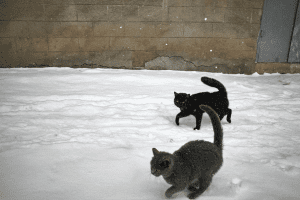Snow, sleet, and freezing rain fall on Huskies and Chihuahuas alike. While some pets have more of an affinity for winter weather, extreme temperatures come with risks for all dogs and cats.
Before you and your companion head out into the frosty air, here are a few tips to help you enjoy the cold weather safely.

The saying “if you’re cold, they’re cold” is true — and then some.
Pets have a warmer healthier body temperature than humans (around 100.5-102.5°F for cats and 101-102.5°F for dogs). Despite their fur coats, mild hypothermia can begin to set in if their internal temperature dips below 99°F.
In general, pet parents should exercise caution anytime the forecast calls for temps below 45°F. There are many factors that can influence your pet’s individual cold tolerance, but be especially mindful of:
When the weather is harsh, pets belong inside
Raleigh, NC laws prohibit long-term tethering year-round, but the practice is especially dangerous in winter. Pets left to fend for themselves can suffer when their water bowl ices over or their bedding collects moisture and freezes overnight. Any night that you would consider too cold for camping is a night that your pets should spend indoors.
Headed out for exercise or bathroom breaks? Much like you have to be mindful that sidewalks aren’t too hot for pets’ feet in the summer, cold temperatures can also cause injuries.
Snow, ice, and road salt can be very irritating to paws. Not all dogs will tolerate wearing booties, so it’s important to inspect feet for redness and open or flaky skin after walks. Trim the fur between your pet’s toes so that less snow and ice cling to their feet, and dry paws thoroughly when you get home to help them warm up.
It’s a pet parent’s worst nightmare: an excited dog runs out onto a frozen pond in pursuit of a bird or squirrel, and the ice can’t support their weight. Be cautious around bodies of water this winter, and keep pets leashed to prevent accidents.
 5. Check Your Vehicle Before Starting It
5. Check Your Vehicle Before Starting ItOutdoor cats in search of a warm place to sleep will sometimes crawl up into car engines. The results can be tragic when unsuspecting drivers turn the key.
Even if your cats are safely indoors, stray and feral animals may still be at risk. Knock on the hood or take a quick look inside before you head out for the day, and you may save a life.
You’re probably well aware that it’s dangerous to leave pets in the car on hot days, but what about cold ones?
When temperatures are low, condensation inside your vehicle can cool rapidly, turning your car into a refrigerator. Though the interior may seem cozy at first, on freezing days, conditions are only a few minutes away from becoming dangerously cold.
Antifreeze is an important part of winter car maintenance, but even small amounts can be fatal to pets. An estimated 10,000-90,000 animals die from antifreeze poisoning each year.
Because it has a sweet taste, pets will seek out and consume antifreeze that isn’t properly stored. Lock it up or switch to nontoxic formulations.